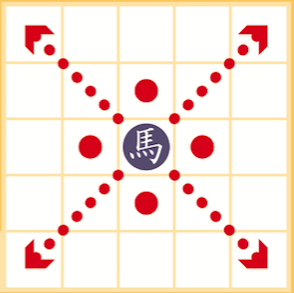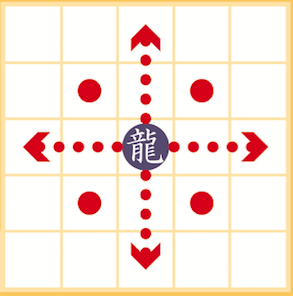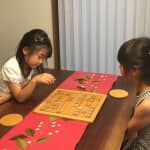21 March 2017
Shogi Rules – How to Play Shogi – : Step 2-4 Moves of Promoted Pieces
Explore art of Shogi. A professional Shogi player invites you to the world of Shogi along with traditional Japanese culture.
In the last lesson, you learned that pieces may be promoted once it reaches the opponent’s camp, turning them over. Promoted pieces are called as Narigoma. Today’s lesson is going to cover what’s Narigoma and to remember them.
Piece Moves
Fu (Pawn), Kyo (Lance), Kei (Knight), Gin (Silver): all is to be promoted to one that move in the same way as Kin (Gold).

Hisha (Rook), Kaku (Bishop): both are to be promoted with their original moves gaining moves of Ou (King).
Moves of Uma (Promoted Bishop)

Moves of Ryu (Promoted Rook)

Hisha (Rook) and Kaku (Bishop) are called “Ogoma, or Major piece,” which move any number of squares in any of the orthogonal/diagonal directions. They will become by far stronger after their promotions. After a promotion, Hisha (Rook) will become Uma (Promoted Bishop), and Kaku (Bishop) will be Ryu (Promoted Rook). Ryu is imaginary creature, as you know. It sounds strong, doesn’t it?
Pieces to be Promoted
In the last lesson, Step 2-3 “Promotion,” I told you that it’s your option to choose whether or not you make your piece promoted. Since Fu (Pawn) and Ogoma, Hisha (Rook) and Kaku (Bishop), will gain new moves to be added to their original ones, basically I would say you should make your piece promoted. For other pieces, you might want to decide it on case by case basis. For example, Kei (Knight) will lose its original jumping moves, so in some situations it will work better without its promotion.
Practice to Move Promoted Pieces
Let’s enjoy a game designed to learn moves of promoted pieces. This is the one we introduced in our blog, named “Tag chasing a King.” You need only three pieces for this game. Using one Hisha (Rook) and two pieces of Kaku (Bishop), you will chase Gyoku (King). It allows you to remember the moves of promoted pieces of Hisha (Rook) and Kaku (Bishop), and develop your sense of utilizing pieces. If parents will be a child’s opponent, take a Gyoku (King) part and run away effectively.

After the lesson
I tried to play this game, “Tag chasing a King.” I found it provided opportunities to learn move of promoted pieces and the way to give checkmate. At first, only three pieces seemed not to be enough to play, however I noticed that not only they were enough, but the game had profound purpose. As the game will be over in quite a short time, you may play it again and again. Thanks to this game, I learned the move


